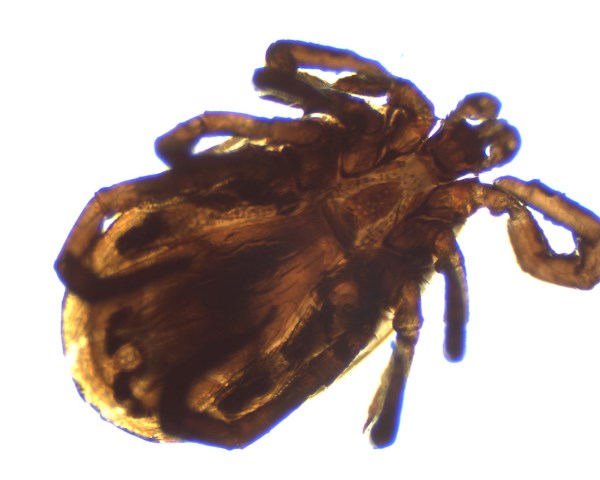Of all the pet parasites, ticks are the one that seems to bother people the most. Tick populations are rising, and the number of diseases they carry is spreading, so being aware of ticks and how they are acquired is becoming more important in our area.
There are several species of ticks in New England. For the most part, the species we deal with are called “three-host ticks”. This means that they need to take a blood meal at each stage of development. The eggs are laid in leaf litter or similar environments, and hatch into larvae. The larvae feed on small mammals, then detach and moult into nymphs. The nymphs then need to take a blood meal before detaching and moulting into adults. The adults are the ones we see most commonly, and they also need a blood meal before they can mate and lay eggs, starting the process over again. While the adults are the most noticeable, the younger stages can attach to dogs and cats, and are so small that they may never be detected.
Everyone knows that ticks carry the bacterium that causes Lyme disease, but there are other diseases that ticks can cause as well. The rarest are hypersensitivity reactions (like an allergic reaction) that can range from an itchy swelling at the site of the bite, to a more significant generalized reaction. The rarest non-infectious disease caused by ticks is called tick paralysis, and results from a neurotoxin in the saliva of certain female ticks. Removing the tick usually stops the paralysis, but it still can be a severe condition.
Ticks can serve as the vector for a number of bacterial and protozoal pathogenic organisms. Borrelia burgdorferi is the bacterium that can cause Lyme disease, and is the most common of these organisms in New England. Thankfully, cats are relatively resistant to developing Lyme disease, and dogs are more resistant than people. There is a lot of controversy about this disease, both in the human and veterinary medical professions, which results from an incomplete understanding of how the bacterium creates disease. In dogs, testing positive for exposure does not necessarily mean that the dog has the disease or will ever develop the signs of illness. That said, some dogs do get sick, and preventing ticks on the dogs is the best way of preventing the disease.
There are other agents present in New England ticks that can cause disease, and the incidence is rising. This is due both to natural expansion of the range of the organism, and to dogs and people bringing in both ticks and disease from other parts of the country through travel and adoption.
The best prevention for all of these is preventing ticks from attaching. People should be aware of local tick incidence, and stay away from areas with high tick populations if possible. If that is not possible, people should wear light colored clothing (to make it easier to see and remove ticks) and check themselves carefully for passengers after returning home. Outdoor cats should be on a product that controls ticks, and also should be checked on a regular basis. Cats will groom ticks off their bodies, but they cannot reach their own heads, so focus your attention on the head, neck, and face. Dogs should also be on a preventive, and be checked on a regular basis. Use your fingertips to gently massage along the skin, feeling for any tiny lumps.
Ticks do not burrow their entire body into the host; they hold on with their jaws. To remove a tick, grasp it firmly where it is attached (try not to squeeze the body) and pull out at the same angle it went in. There are a number of “tick-pullers” or “tick-keys” marketed to assist with removing ticks in this way. You can kill the tick by drowning it in rubbing alcohol and then throw it away. Wash your hands carefully after handling a tick, and clean the area where it was attached with rubbing alcohol. Check the site daily for several days to monitor for excessive swelling or redness. A small, hard lump at the site is common. It often forms a scab, and often seems to be itchy. Dogs and cats do not form the “bulls-eye rash” that people can develop after being infected with the bacterium that causes Lyme disease.
While no one likes to think about ticks when out enjoying a lovely summer day, keeping aware of the possibility and doing all you can to prevent attachment will go a long way to preventing any tick borne illness.





